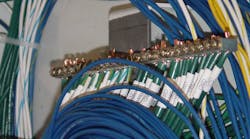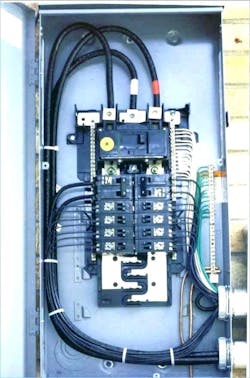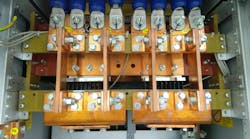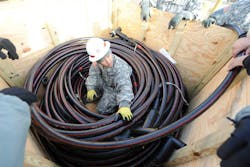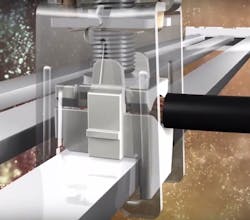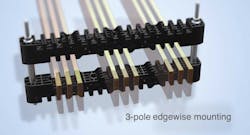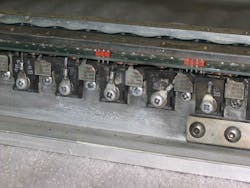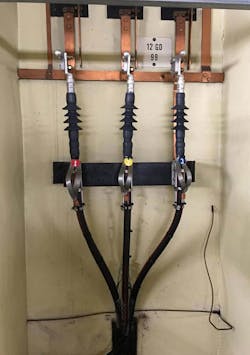What’s the Difference Between Busbars and Cables?
Open an electrical panel and you will likely find a bus bar or two along with circuit breakers. Distributing large currents efficiently is more than just dropping a hunk of metal between two points. Designers need to take into account a number of factors like the metals used, heat dissapation and structural integrity,.
This article explores the advantages, applications, and comparisons of busbars and cables, providing insights into their roles in electrical design and installation.
What are Busbars and Their Role in Electrical Panels?
Busbars are metal bars used to carry large amounts of current. Often made of copper or aluminum, every home electrical panel has busbars to distribute ac power to the rows of circuit breakers (Fig. 1).
Read More About Busbars
Quite often, busbars have no insulation—they’re protected by a separate enclosure. Cables can’t have insulation when used for ground connections; more typically, they have an outer jacket that provides electrical isolation and shock protection (Fig. 2).
Busbars and a Lack of Insulation Can Be Good
The lack of insulation means busbars are easier to recycle; you don’t have to strip or burn off any insulation. They are simply a chunk of metal.
The lack of insulation on a busbar can also mean it’s easier to tap off power anywhere along its length (Fig. 3).
Cables Insulation Benefits
The insulation on a cable means it’s possible to reduce its inductance by making it into a twisted pair. To better couple busbars, you can run them close together. However, it’s difficult to intertwine them like cable. Still, a busbar can provide a lower high-frequency impedance compared to a single cable if it has more surface area that can take advantage of the skin effect. Interleaved busbars are able to help overcome non-uniform current distributions due to the proximity effect.
The lack of insulation on a busbar can also be a benefit in a fire. With no polymer materials to decompose and give off toxic gases, a busbar might be a safer design choice.
A cable will shine where you have motion or vibration that the cable can accommodate, whereas a busbar would not. Then again, the lack of motion compliance in a busbar might be just what you need if you have variable currents that might cause motion in cables due to magnetic coupling. Some of the motion a cable can accommodate is due to thermal expansion, no matter if the temperature change is from ambient conditions or from the current carried in the cable.
A busbar is a structural element and might need fewer supports compared to an insulated cable (Fig. 4). On the downside, if your application has a lot of twists and turns in the power routing, a cable may be simpler to route rather than bending up a complex busbar. This could also mean that cable systems are easier to change if power sources or loads move around in your system.
Using Busbars as Heatsinks
One beneficial difference associated with a busbar is that it can also be used as a heat sink (Fig. 5). If you have to feed power to the cases of many transistors, it’s possible to pull away the heat in the same structure that delivers the current. Be aware that the thermal expansion of the busbar is sure to be different than the PCB that you use in conjunction with it. Therefore, you should ensure there’s adequate compliance in the transistor leads and other connections to the busbar.
This brings to mind another difference between busbars and cables. You can use a busbar on a printed circuit board (PCB) to not only carry large currents, but to stiffen the PCB and keep it from warping (Fig. 6). This can be advantageous since you’re using the busbar to carry the current, and then transferring current to the PCB to distribute the power. Thus, the busbar is an inexpensive standard item you need only cut to length in a simple operation, or perhaps order it cut-to-length.
Another difference between busbars and cables is that you can make a PCB into a busbar, as is done with Bergquist ThermalClad PCB material, and Rogers ROLINX capacitor-busbar assemblies. Using a PCB-busbar system has become common to power LED lighting, since it can handle high currents as well as remove the heat from the LED system. There are also ways to laminate a busbar into the PCB (Fig. 7).
Looking at Busbar Costs
Cost is a fundamental driver in engineering decisions. There are no simple cost analyses as to the difference between busbars and cables. Since busbars aren’t made from several thin strands like braided cable, and have no insulation, they can be cheaper per ampere carried. Yet, you will have to create drawings and tooling to make a busbar, and you must provide insulation protection somewhere, perhaps as part of the enclosure.
If you need to make frequent changes, a cable may be easier to re-route, or maybe a busbar would be simpler if you only have to move a tap along its length. If you can use a busbar to remove heat, then it could well be cheaper than a cable with an attending heat sink. The recycling value of a busbar should be greater since it has intrinsic value as a piece of metal.
You might save money with aluminum busbars or aluminum cables, but the major headache is termination to aluminum. It may be cheaper to make a reliable termination to an aluminum busbar, or in some cases it might be less expensive to terminate aluminum cables.
There’s a place for both cables and busbars (Fig. 8). In engineering, costs are always plural. So, it’s not just the cost of the cable or the busbar, but the costs that those components will incur on your entire system. This can even extend to end-of-life costs when you have to scrap or salvage your products. Doing research and evaluation of both cable and busbar systems will give you a choice, and that choice should be easier once you know all of the implications.
